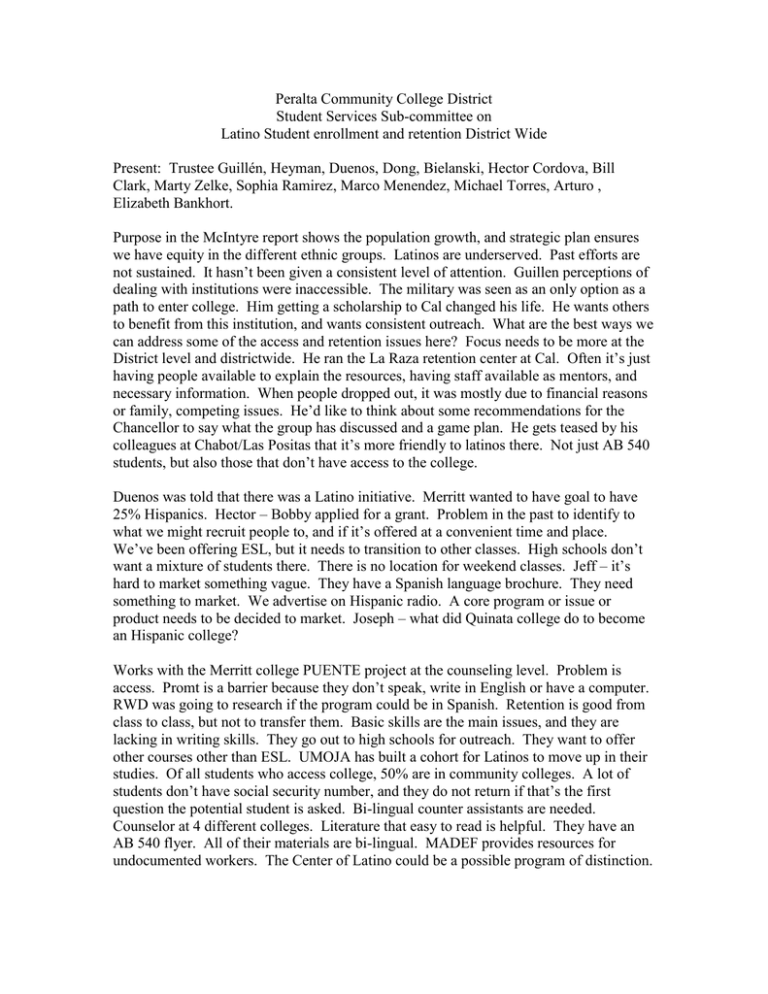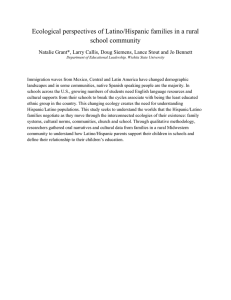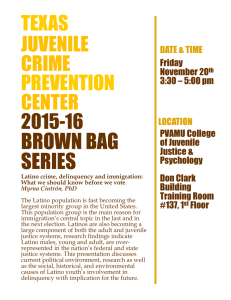Peralta Community College District Student Services Sub-committee on
advertisement

Peralta Community College District Student Services Sub-committee on Latino Student enrollment and retention District Wide Present: Trustee Guillén, Heyman, Duenos, Dong, Bielanski, Hector Cordova, Bill Clark, Marty Zelke, Sophia Ramirez, Marco Menendez, Michael Torres, Arturo , Elizabeth Bankhort. Purpose in the McIntyre report shows the population growth, and strategic plan ensures we have equity in the different ethnic groups. Latinos are underserved. Past efforts are not sustained. It hasn’t been given a consistent level of attention. Guillen perceptions of dealing with institutions were inaccessible. The military was seen as an only option as a path to enter college. Him getting a scholarship to Cal changed his life. He wants others to benefit from this institution, and wants consistent outreach. What are the best ways we can address some of the access and retention issues here? Focus needs to be more at the District level and districtwide. He ran the La Raza retention center at Cal. Often it’s just having people available to explain the resources, having staff available as mentors, and necessary information. When people dropped out, it was mostly due to financial reasons or family, competing issues. He’d like to think about some recommendations for the Chancellor to say what the group has discussed and a game plan. He gets teased by his colleagues at Chabot/Las Positas that it’s more friendly to latinos there. Not just AB 540 students, but also those that don’t have access to the college. Duenos was told that there was a Latino initiative. Merritt wanted to have goal to have 25% Hispanics. Hector – Bobby applied for a grant. Problem in the past to identify to what we might recruit people to, and if it’s offered at a convenient time and place. We’ve been offering ESL, but it needs to transition to other classes. High schools don’t want a mixture of students there. There is no location for weekend classes. Jeff – it’s hard to market something vague. They have a Spanish language brochure. They need something to market. We advertise on Hispanic radio. A core program or issue or product needs to be decided to market. Joseph – what did Quinata college do to become an Hispanic college? Works with the Merritt college PUENTE project at the counseling level. Problem is access. Promt is a barrier because they don’t speak, write in English or have a computer. RWD was going to research if the program could be in Spanish. Retention is good from class to class, but not to transfer them. Basic skills are the main issues, and they are lacking in writing skills. They go out to high schools for outreach. They want to offer other courses other than ESL. UMOJA has built a cohort for Latinos to move up in their studies. Of all students who access college, 50% are in community colleges. A lot of students don’t have social security number, and they do not return if that’s the first question the potential student is asked. Bi-lingual counter assistants are needed. Counselor at 4 different colleges. Literature that easy to read is helpful. They have an AB 540 flyer. All of their materials are bi-lingual. MADEF provides resources for undocumented workers. The Center of Latino could be a possible program of distinction. Bi-lingual counselors are important. Adjunct, part-time counselors are bi-lingual, but that’s a problem that there are not more full-timers. Laney also has a wood technology program which has been hugely successful. Laney has been trying to fill in the gaps of what Merritt can’t provide. We have to have multiple levels of attack, going to nursery schools as well as nursing homes, so they are trying to build on elementary school relationships and to build relationships in the community. There seems to be a void in West Oakland. East Bay Career advancement academy program was explained. It is possible to plan within this for year 3 or summer. The program started from faculty initiation. Coordination across the board for all of Peralta should be a priority. An assessment of community needs, including transfer students, to contact businesses with employees needing classes to know what they want and when. Spanish legal interpretation program will have courses in the Fall, which is a special niche for us. The demographics are needed to document, which is 29%, and we serve about 16%. 55-60% of Latinos don’t speak Spanish, also. So there is a list of programs we offer that could be packaged. Theatre arts have no income to apply to this. If there’s funding, he has actors to bring in to do workshops on theatre. He could get a comedy troop here for the right price. Latino film festival/Fiesta is a possible idea, leading them to the college. Community theatre would be fun to get interest, too. It would be nice for each college to have a Latino center. We need student ambassadors to send representatives to schools and religious centers. Sports programs should be better advertised. Independence day celebrations, Cinco de Mayo, and Los Dias de los muertas need to be highlighted. There should be a coordinator for each aspect, such as access and retention. TRIO grant was explained. She advocates a search on best practices. Those applying for a Title 3 grant can’t also be awarded a Title 5 grant. All 4 schools should be a member of HAKU to build our Hispanic membership, and they will share the best practices. Co-op grant can be in an agreement with any other school. The money could then be divided between the school, as it’s hard to find partners. West Hills Los Pedanos has been successful. Next Spring or Summer would be the deadline for this. Latino day was 2 years ago. It would be nice to have a party around registration time around September. One office and zero budget at Merritt that is general funded in the transfer center. Idea of a campus-wide recruiter was discussed. Every campus has an outreach coordinator already, but that person needs more support, along with having a latino center/campus. We don’t have a centralized place to send people, as we need infrastructure to support this, with Spanish applications and website. There needs to be a place for them to go to the Latino centers. Gateway to College program was also explained. Bi-lingual tutors are also needed. A Latino summit idea was presented to bring students to the college after they’ve received college acceptance letters. Workshops could occur, music, food, speaker, college tour. It would be better to have one Latino, African American, and Asian American recruiter. Bill suggests we go after students that we want, even before students get acceptance letters. The equity plan spells out the desired needs, which is a better framework from which to work. We need to continue building a presence in the community. Counselors in other schools need to be spoken to. Student ambassadors help a lot. Colleges all need more counselors. BSI is also a whole pool of fund towards tutorial services. President and Chancellor discretionary funds should be solicited. Hybrid and online course also need to be developed. It’s suggested to see what’s here district wide, listen to faculty and students, before we get to list that we recommend. It’s suggested that we pay someone to do focus groups to do this for a small fee. That document will be needed before we go out for larger funding. Goal to have equity within 4-5 years relative to the service area. Jeanette needs to know what is needed so that she can spend down money when the time is right. This group could report back to each campus group if there is a Latino recruitment committee. We want to make the pie bigger for everyone, and not have people compete for the same funds. Career Ladders could be a good resource for this group.


